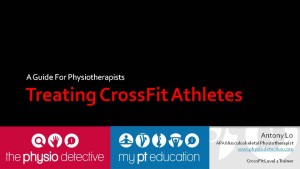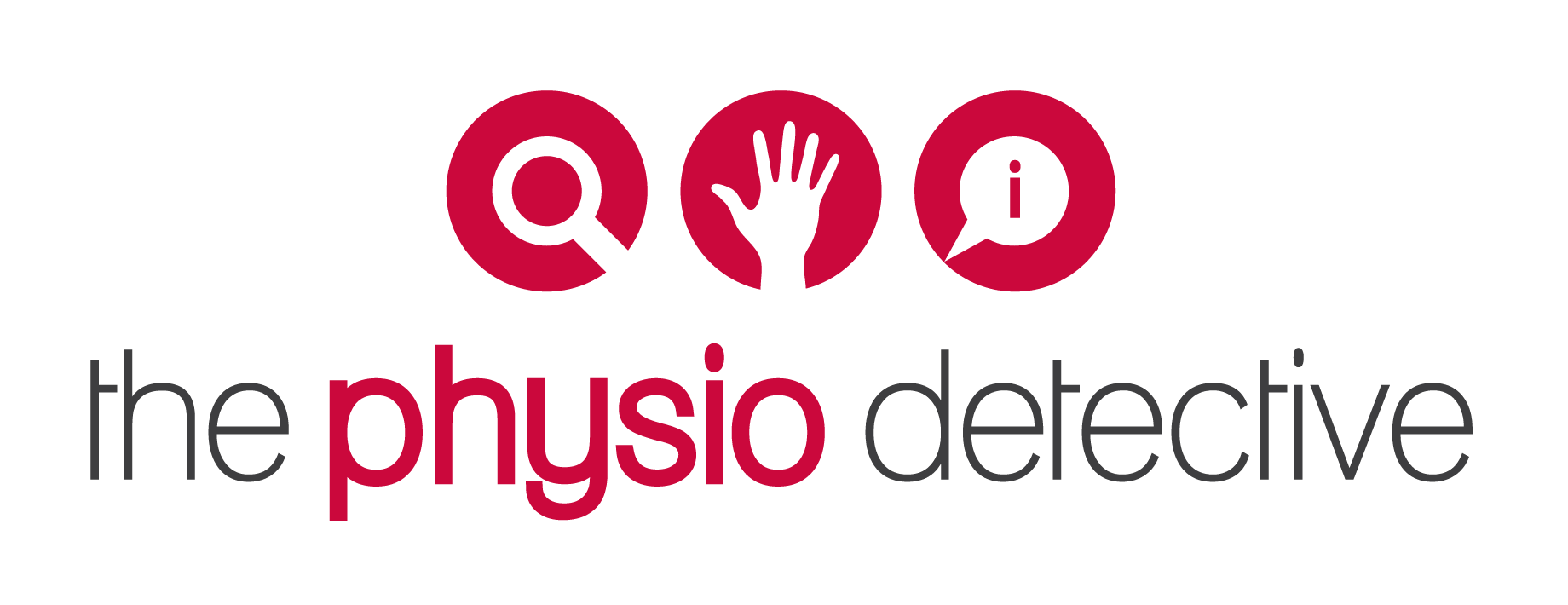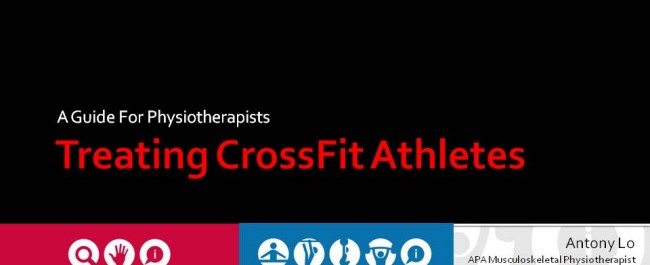CrossFit and Physios – What Some Coaches and Athletes Want Physios To Know
 I recently gave a talk for the Australian Physiotherapy Association Sports Physiotherapy Group on how to treat CrossFit athletes from the beginner to the elite. (PS, I hope to have this talk available for purchase soon!)
I recently gave a talk for the Australian Physiotherapy Association Sports Physiotherapy Group on how to treat CrossFit athletes from the beginner to the elite. (PS, I hope to have this talk available for purchase soon!)
In part of my preparation, I collected responses from people about the following question:
"What would you like me to tell other physios about CrossFit and how to treat you? Include your pet hates!"
Below are their responses... please feel free to add your own in the comments section below.
AL
- Don't tell someone to stop training unless they are comatose
2. Scaling is a real thing. Standing up from a box counts as CrossFit
3. Good cross fitters train smarter, not harder (although it is a lot harder than I train!)
4. There are lots of ideas on how to self diagnose and treat. Sometimes reeducation and PROOF is needed to change beliefs
5. The human body is capable of so much more than we think
6. Crossfit patients are THE BEST kind of patient because they want to get better and back to full training
7. Demonstrate, test and measure why a technique correction or cue is good or bad.
RL It's a sport. Treat me as you would any athletic patient.
LM Proper movement. Most physios are stuck in the past about knee tracking vs knee loading, shoulder position, body position with weight overhead, foot position in a squat, torque through the hips and loading on the body, as specially with athletes
MM I don't want to hear 'stop doing what causes you pain' - what I want is a solution to the pain so I can continue doing what I enjoy... Making myself sore
JS They need to understand that "success" is different to a CF (or other sports) client. Getting them to achieve pain free sitting, walking, etc doesn't solve the problem they've got. They want relatively pain free snatching, squatting etc at maximal loads and high intensity. Therefore a solid understanding of what that training entails is crucial for a Physio to provide a successful intervention. Don't know how many times I've heard "Physio/doc/osteo told me to take 2 weeks off, and it was good at first but after a while it flared up again". Just simple ignorance of what the client is trying to achieve.
In summary, physios should go do Crossfit.
CF Knowing movement and looking at causation rather than treating an area in isolation. I cannot stand a practitioner of any sort telling their patients certain things are dangerous when they cannot move themselves nor know/understand movement. So many do not even take into account every day posture- it infuriates me!! Mobility/rehab have progressed so much further than the majority of practitioners I know are handing out. Stock standard treatment of each person is no longer sufficient. I want to know how something is caused, what treatment- mobility/rehab/prehab and how to move better so that it doesn't reoccur! Not too much to ask is it...
JH Okay so after a year of back/neck/shoulder problems I have been told don't do this and don't do that, and since doing Crossfit I have done everything that I was told not to and all my issues have gotten better with extra work as well, so probably they need to know stop telling people to stop stuff and say if you do ..... Then you need to do this to compensate and build this to counter balance, this is why Vaughn is so good with his coaching etc
LH Ant, The biggest thing I would ask Physio's to do, is to give them corrective exercises. Movements that can be done In a box. I have members come to me saying " I need to take 2 weeks off to fix my injury" where they would be best at the box, working on the issues. Their "fixing" solution is to stay away and rest, with no specific plan in place. I know this has been mentioned above but a corrective action plan is important for us coaches to ensure they are moving in patterns that will not create any further damage.
MN Communication with Coaches. I personally welcome any feedback/report I can get from any professionals. As most of the time unless they have trained with us there is little or no understanding of what we actually do. Open a line of communication with the coach to achieve the best outcome for the athlete/client. Pretty much all Crossfit coaches I know would be open to more of this happening and it gets rid of the "stop doing Crossfit" response.
AL I think the other thing physios don't realise is that asking someone to stop attending has social, psychological and just plain physical effects.
1. Social - the gym is where your "other family" is at. You spend an hour a day there at least, usually with the same people so you end up going through life together. Asking someone to stop training and going to the gym is also saying "stop seeing your mother/father/sister/brother". Social isolation does NOT help people get better
2. Psychological effects. Cross fitters who train 6 days per week (including active recovery or an easy rest day) go NUTS when they can't do exercise. You can always find something to do. Exercise has so many positive benefits.
3. Physical effects. We worked hard for these gains. It is time consuming and expensive. Let me keep working what I can. A sprained ankle doesn't mean I have to stop everything!
Lastly, for the business owners and coaches who do individual sessions, a paused membership is no income coming in. When you see all the benefits of continuing to train in a scaled way, why should a member stop training?
TP Get them to go to a box and watch/take part in a class to better understand what we do and how we think
GB - They should communicate with their CF coach as a fellow professional not some lower class person who doesn't understand.
- Understand we are watching these people move every day almost so we possibly see more movement than they do.
- Stop telling people CF is good for their business. This is because in general CF people go get their problems fixed where the average exercise bunny takes it home, has several beer & Nurofen & waits for the pain to go away. It would be better if they said CF people were great because they really worked on getting their bodies sorted to work well.
SC I found super useful as a young lifter was going to a physio that had a barbell in his practice and when I was rehabbed enough got me to show him my technique with whatever gave me the injury which helped them understand better the mechanisms of injury and how to correct it for my own biomechanics. Was so good.
DH Stop saying things like, "Oh, I love CrossFit. All the injuries it causes pays my bills." It's beyond insensitive, it's downright ignorant. I hear this from PT's in the U.S. all the time. Guaranteed they don't say the same thing to the runners, footballers ... and on, and on, and on.
LM I've spoken to a couple of physios, after losing a lot of weight , one told me to stop crossfit altogether as i would continue to hurt my joints, I realise it's a double edged sword because I'm going to continue training but give me some methods to help me develop/improve my joint dysfunctions instead of telling me to quit what I love doing...
MH - The difference between weight training, weightlifting, powerlifting and cross fit- to highlight just what a Crossfitter does
- Data from well documented research that demonstrates the relatively low risk of injury of the above
- They need to observe the specifics - what movement is problematic - where does this happen in the context of a session (fatigue and endurance)
- Understand the advantage of the use of external movement based cues and the specific one/s that improve performance for that Crossfitter
- How cross fitters adjust/accommodate for anatomical differences
- Performance standards in crossfit
- Injury risk at the Extremes of ROM and how therapists may not prepare one for return to participation if they only work within the middle of the ROM. e.g. Your (Antony's) jumping demo of ankle stability vs sending people back to play once they can stand on one leg and close their eyes without wobbling
MK My physio is fantastic and I send all my clients to him as through my various injuries over the years he has learnt a lot about CrossFit and now understands it. The best thing we discovered is when he discusses training through injuries or coming back from an injury he uses percentages and maximum reps allowed (ie train at 50%, squat at 50%, no more than a total of 50 reps upper body, etc) - CrossFitters understand this. This is then easy to increase the follow week/s (ok you can do 65% this week and 75 total reps) and I've found my clients are much better at "easing" back into it - you know us CrossFitters, sometimes it's just go, go, go!!
CE They should get involved. Get into their local box(es) and experience some sessions, observe how classes are structured etc. To simply sit back and criticise anything without experiencing or at least trying to understand it is ignorant (which is what most athletes I see complain about and why I actively refer to Physios that do CrossFit). Most are okay, but some are frightfully archaic with their attitude and understanding of what is not a new sport but a combination of age old functional movements.
SC My biggest pet peeve is that in a lot of cases there seems to be the missing link in a lot of physio's skill sets between a rehab exercise often done in isolation then a good functional equivalent or even how progressively overload a rehab exercise so the client doesn't get bored of it and discontinue even though the problem may not have been solved completely. This caused me many a repeat injury until again I had a good physio that took basic fundamental rehab exercises and realised that I could do them and function in normal life without pain but without progressively overloading the rehab exercises they were no benefit to me in sport or lifitng as the forces going through my body were so much higher than in daily life. Biggest case point... I had been given clamshells to help with hip stabilisation plenty of times before as this was a problem giving me back pain in lifting. It wasn't until I got a good physio who relised that body weight clamshells for 20reps aren't going to do much in a 1 rm squat or dead and got me doing clamshells with a chain around my leg connected to weights that I could overload via normal program prgression that I finally have stayed pain free and strong in holding external hip rotation. Good physio is worth all the money in the world to someone who likes to push their body a bit.
DM I'm a Physio and I love treating Crossfiter's. I seem to get a fair few of the guys and I think it's because I understand the movements they perform because I do them myself. I don't freak out when someone says deadlift or handstand push-up, I know what it feels like to do a heavy squat or bail on a clean. So I would tell them if they want to get on their level, train with them! With a great coach it's an awesome method of training. Next is to have some understanding what is required for each movement technically, don't say you can't but you can do .... etc, give time periods to when they will be most likely back under the bar and teach them! They are soo keen to learn, spend extra time with them and educate them on their injury. They want to be the specialist of their own body smile emoticon p.s. Physios are awesome haha
SC Interestingly enough I was recently charged with the same task [talking to physios]. I also sought to actually involve a couple of coaches and boxes to help with the two way communication thing, you know they can learn, we, as physios can learn=better outcome for our clients and better client retention for the gyms etc. I would still love to do it this way, with some demos of fundamental movementsts and even a short demo wod etc included but unfortunately it did not seem to be valued by the coaches in quite the same way! So whilst, I acknowledge that many physios tend to be conservative in how they manage patients and don't know much about the 'new' sport of crossfit, the more they can understand about Crossfit principles and the typical mindset ( generalising, of course) the better the outcomes for all. It would be great to see some crossfit boxes organise or be involved in such like sessions! Needless to say, I am going ahead with my presentation shortly, would be interested to hear how yours goes and will take the above comments on board for mine. Thanks
GB Most CF coaches know & understand what the F you are talking about & are willing to be part of the solution. Communicate & share ideas & maybe we have something you haven't thought of so we'll both learn & your client will be coached & monitored all the way to wellness
AM I've actually been to a few physios that when i said what the problem was they didn't look at how i moved. I feel like seeing how I move and feel before and after treatment is important but maybe I've been wrong? Maybe it is just sometimes about the massage?
FM Simply watching YouTube videos is not a good indication of what CrossFit is. Get to a box and experience it .
HH The pelvic floor!! How to help all this leaking going on! Also how to help all those (esp the oldies) who are biomechanically not designed for Oly lifting but are going to do it anyway as it's so much fun:)
BM Maybe even some basics around general CrossFit programming- goals of said programming- and how to substitute movements that people are having trouble with and pathways to build them back to full training. I often find that's why crossfitters see me- to give them both alternatives and a somewhat structured pathway back to full training
SC 1. Most CrossFit coaches aren't cowboys. Rather, they suffer from not having 20 pairs of eyes and the capacity to correct every movement fault they might see in their box. This is the root cause of injuries in CrossFit, not half-arsery (Glassman and Castro notwithstanding).
2. Beyond the comatose thing, ACTIVELY INSIST injured participants in gyms, CrossFit boxes, ballet, team sports, whatever should KEEP TRAINING, either in a limited range, or in a smaller set of movements than they usually would, and work with their PTs and coaches. The number of people I see cancelling gym memberships because they have a manageable injury is distressing, not only from a business perspective, but from a health management perspective as well.
HH What about breath holding & bracing that I see taught with lifting? I'm from a clinical Pilates background so come from a "normal" basal breath with movement, inspiration on effort, but Pilates is not max effort. Is bracing/ rigidity/ breath holding necessary for max lifting efforts?


Main concern for myself reading these comments and coming at the issue from a soft tissue therapy viewpoint, is the numbers saying that the practitioners they go to do not watch them move or asses posture through normal movement let alone through the sports required movements.
Anyone coming into a clinic, especially those involved in sport, should expect to be fully assessed through a range of movement, especially those movements that may be the route cause of the problem.
Oh and sometimes CF’ers – you do need to rest! That usually means, when I advise it, rest from the movement(s) that is instigating the pain, and that may just mean reduction in load or range, but rest is often part of the cure!
Fair points Rob.
You would think an assessment of their problem movements would be assumed but apparently it isn’t 🙁
With the rest bit, it is relative rest. To a crossfitter, if you outline what they can and can’t do, especially to smash themselves, they usually stick to it. 🙂